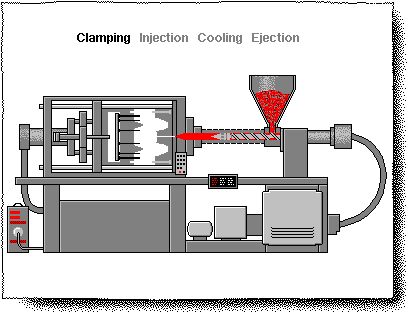1, What is injection molding making?
Injection molding is a manufacturing procedure by which parts are produced by injecting material in liquid form into a mould. It is most normally performed with thermoplastic polymers, but can be used with a range of other materials to include metals and glass. The procedure works by heating small pellets of material into a molten liquid and then pressuring the hot liquid through a nozzle and into a mould whose internal cavity is the opposing of whatever part is being produced. The molten parts are cooled and after that removed from the mould by ejector pins.
Injection molding follows a four-stroke cycle as shown in the diagram above. The mould cavity is filled with molten material, then the material is quickly cooled causing it to harden (turn solid). Next the mould cavity opens, revealing the part to the air and giving it a place to fall, which it does when finally it is ejected by pins.
2, Where is injection molding making done?
There are a lot of injection molding making companies in the China, and if you are looking for full manufacturing and assembly of products at production volumes. IMOULD TECH can get you from a novel prototype design to a fully engineered injection molding-ready tooling and then through to finish of the manufacturing process.
3, Why is injection molding making done (i.e. what is injection molding making used for?).
There are a lot of important advantages to injection molding making. Here is a list of the most relevant:.
Injection molding can be fully automated and therefore permits very high rates of production (you can mass-produce parts very efficiently through injection molding making processes).
Injection molding allows for the production of highly detailed and elaborately designed parts. You will need an engineering design company or an in-house department to make credible designs, however, once the part is ready for and produced through injection molding making, there is very little ending work that has to be done. Parts come out looking very finished.
You can use a range of materials in injection molding making along with combine different materials to synthesize preferable material properties in your end product. The combination of more than one injection molded material (generally two different materials) is called co-injection molding. Generally there is hardly any waste during injection molding making as excess material can be easily repurposed for re-use.
You can use mould inserts to produce new parts (this allows you to change the internal cavity without needing to completely redesign and re-machine the aluminum or steel tooling by CNC). mould life will obviously based on the material used in injection molding making, and in specific on the part geometry and the barrel temperature of the injection molded material. High temperatures and delicate (thin) geometry will reduce tooling life.
There are also some considerable disadvantages to injection molding making – namely the fact that high mould costs keep it unreachable of the average independent designer. With that in mind, it’s useful to consider the alternatives.
4, What are the alternatives to injection molding making?
Several other technologies are available for manufacturing outside of injection molding making. Most of these do not compare for large order manufacturing but may be useful for small-scale projects where only a few hundred or a thousand units are needed. Here are a few to consider:.
3D Printers (FDM et. al. machines): Advances in 3D printing have made it available for smaller scale users. For projects without an enormous scale where materials aren’t necessarily “set in stone,” FDM, SLA, SLS, and SLM machines are a possible alternative.
Spin Casting: Spin casting uses a rubber mould and centrifugal force instead of the steel mould (typical for injection molding making) and an injection molding making machine to produce products. Generally, spin casting is done using cured rubber moulds that are generated by casting the molten rubber around the original object (prototype). The advantage to spin casting is that a rubber mold can be an order of magnitude cheaper to produce than a steel tool with an internal cavity. If you are only looking for a small number of parts, this is likely to be a better match. Conversely, the advantage to steel tooling is that it holds up much better than rubber and is designed to be used in injection molding making machines providing the capability to produce tens of thousands of parts from the same mould.
Get A Free Quote

